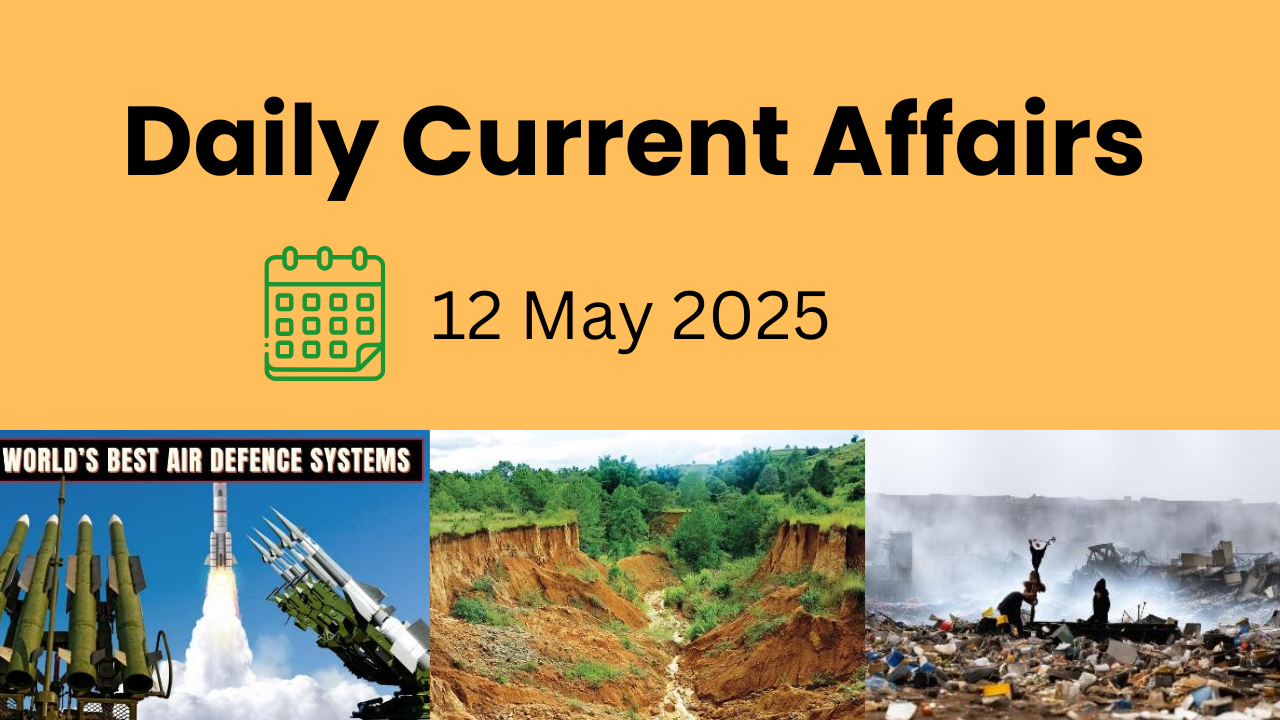1. Air Defence Systems: Safeguarding the Skies of India and the World
Context: In a significant demonstration of military preparedness, India recently repelled aerial attacks launched from Pakistan along the western front. In a strategic counteroffensive, Indian forces successfully neutralized an enemy air defence installation near Lahore. These events underscore the crucial role played by air defence systems in ensuring national security and deterrence.
Understanding Air Defence Systems:
Air Defence Systems form the backbone of a nation’s aerial security, tasked with the detection, tracking, and elimination of hostile aerial threats such as enemy aircraft, missiles, and drones. These systems are typically composed of a layered defensive architecture, incorporating cutting-edge technology like radars, missile interceptors, electronic warfare systems, and command-control networks.
Core Components of Air Defence Mechanisms:
1. Detection and Surveillance:
- Radar Systems: Utilize high-frequency electromagnetic waves to identify incoming targets, even at long distances.
- Satellite and Infrared Sensors: Provide high-resolution imaging and thermal tracking to spot stealth aircraft and hypersonic threats.
- Tracking and Threat Classification: Algorithms assess object speed, altitude, and flight path to determine whether the intruder is a fighter jet, drone, or missile.
2. Command and Control:
- Combat Operation Centers: Evaluate threat levels and coordinate a multi-layered response, including missile interception or electronic warfare.
3. Engagement and Elimination:
- Surface-to-Air Missiles (SAMs): Serve as the primary tool to destroy aerial threats at various ranges.
- Electronic Warfare Systems: Include signal jammers and spoofers to confuse or disable enemy radars and communications.
- Anti-Aircraft Artillery: Offers close-range defensive firepower, crucial during saturation attacks or when SAMs are not feasible.
Classification of Air Defence Systems:
Short-Range Air Defence (SHORAD):
- Designed for low-altitude, close-proximity threats like drones and cruise missiles.
Example: Barak-8 Missile System
Medium-Range Air Defence (MRAD):
- Provides protection over broader zones, effective against fighter aircraft and tactical missiles.
Examples: Patriot Missile System, S-400 Triumf
Long-Range Air Defence (LRAD):
- Capable of intercepting threats over hundreds of kilometers, including intercontinental ballistic missiles (ICBMs).
Examples: THAAD, Aegis BMD
India’s Air Defence Arsenal:
Akash Missile System:
- Indigenous Surface-to-Air Missile system.
- Can engage multiple airborne targets with command-guided precision.
- Effective against aircraft, cruise missiles, and UAVs.
S-400 Triumf (From Russia):
- Among the world’s most advanced LRAD systems.
- Intercepts threats at distances up to 400 km.
- Capable of engaging stealth aircraft, ballistic missiles, and drones.
- Also deployed by China and Turkey.
Barak-8 Missile System (India-Israel Collaboration):
- Quick-reaction interceptor for aerial targets.
- Deployed on naval vessels and land-based launchers.
- Offers 360-degree coverage against supersonic threats.
Integrated Counter-UAS Grid:
- Specialized system against unmanned aerial threats (UAVs).
- Combines radar detection, electronic jamming, and kinetic weapons for neutralization.
- Deployed along sensitive borders, including the Line of Control (LoC).
Notable Global Air Defence Systems:
Patriot Missile System (USA):
- Multi-role air and missile defence system.
- Used by USA, Germany, Japan, Saudi Arabia.
- Capable of intercepting ballistic and cruise missiles.
Iron Dome (Israel):
- Designed for short-range interception, highly effective against rockets and artillery.
- Widely used to defend urban areas and military bases.
- Demonstrated over 90% success rate in combat situations.
THAAD (Terminal High Altitude Area Defense) – USA
- Intercepts ballistic missiles in terminal phase.
- Operates at exosphere altitudes, enhancing strategic coverage.
- Deployed in South Korea, Japan, and Guam for regional deterrence.
Aegis Ballistic Missile Defense (USA):
- Sea-based missile defence system installed on Aegis-class destroyers.
- Utilizes Standard Missile-3 (SM-3) for high-altitude interception.
- Integral to NATO and Indo-Pacific security strategies.
Additional Insights and Emerging Trends:
- Hypersonic Threats: Nations are now developing countermeasures against hypersonic glide vehicles (HGVs), which travel at speeds exceeding Mach 5 and can evade traditional radar.
- AI in Defence: Artificial Intelligence is increasingly used for threat assessment, radar signal processing, and autonomous targeting.
- Multi-Domain Integration: Modern air defence is moving towards integration with space, cyber, and naval assets for real-time threat coordination.
Conclusion:
As aerial threats evolve—from swarms of drones to stealth bombers and hypersonic missiles—nations must continually upgrade their air defence capabilities. India’s robust and modernizing air defence network, integrated with indigenous systems and global technology partnerships, plays a pivotal role in maintaining national sovereignty and strategic deterrence.
2. CCI Overhauls Cost Regulations to Tackle Predatory Pricing in Digital Markets
Context: In a significant regulatory shift, the Competition Commission of India (CCI) has issued the “Determination of Cost of Production Regulations, 2025”, replacing the older 2009 framework. This new regulation marks a critical update in India’s antitrust oversight, specifically targeting predatory pricing and deep discounting, particularly in e-commerce and quick-commerce sectors.
Understanding the Context: Predatory Pricing and Market Fairness
Predatory pricing refers to the strategy of selling goods or services at prices below production cost with the intent to undermine competition or drive rivals out of the market. Under Section 4 of the Competition Act, 2002, such conduct is considered an abuse of dominant position and is subject to strict scrutiny by the CCI.
The now-superseded Cost Regulations, 2009, were developed in a pre-digital era and struggled to address the complex economics of modern, platform-based markets, where cross-subsidies, free services, and non-cash value have become common.
Highlights of the 2025 Cost Determination Framework:
1. Adaptive and Sector-Neutral Design:
- Moves away from the rigid one-size-fits-all structure.
- Allows case-specific evaluations, recognizing the distinct dynamics of digital, retail, telecom, and tech-driven platforms.
2. Focus on Internal Production Cost:
- Establishes internal cost of production as the benchmark for pricing analysis.
- Rejects the use of market value as a benchmark due to its reliance on consumer perceptions, subsidies, or branding, which may not reflect actual cost.
3. Aligned with Global Best Practices:
- Incorporates insights from international competition authorities and modern economic theory.
- Builds on evolving jurisprudence on platform economies, network effects, and dynamic pricing models.
4. Clear Framework for Evidence-Based Investigations:
- Offers the CCI a standardized yet flexible approach to assess pricing practices.
- Enables deeper scrutiny of pricing algorithms, subscription bundles, and freemium models.
Why This Matters: Implications for India’s Competition Ecosystem
Legal and Regulatory Clarity:
- The 2025 regulations provide a more objective and economically sound method to determine cost benchmarks.
- Enhances legal certainty for firms operating in highly competitive and tech-driven sectors.
Digital Economy Focus:
- The framework explicitly considers cross-subsidization, high fixed costs, and non-linear pricing strategies—hallmarks of startups and digital giants.
- Enables CCI to effectively assess zero-price markets, like those offering free apps or services.
Level Playing Field for MSMEs:
- Protects Micro, Small, and Medium Enterprises (MSMEs) from being priced out by loss-leading strategies of dominant players.
- Encourages fair competition and innovation by ensuring market access for smaller businesses.
Better Enforcement Capacity:
- Empowers CCI to conduct more precise, consistent, and data-driven investigations into alleged anti-competitive pricing.
- Strengthens India’s regulatory readiness in the face of rapidly evolving digital business models.
Global Context and Comparative Insight:
- European Union and United States regulators have also faced similar challenges in defining cost metrics in platform economies.
- Countries like Australia and Japan have adopted dynamic tools to regulate pricing in sectors such as ride-sharing, e-retail, and online food delivery.
- India’s 2025 regulation brings it in line with mature jurisdictions, reinforcing its role as a progressive antitrust authority in the Global South.
Conclusion:
The 2025 Cost of Production Regulations represent a forward-looking approach to maintaining fair competition in a rapidly digitizing economy. By modernizing its toolkit, the CCI is better equipped to curb exploitative practices, preserve consumer welfare, and protect India’s competitive digital landscape from monopolistic abuse.
3. Invisible Scars: The Growing Threat of Gully Erosion
Context: A recent study published in Scientific Reports warns that gully erosion, a severe form of land degradation, poses a direct threat to the achievement of at least nine out of the 17 Sustainable Development Goals (SDGs). It particularly endangers efforts related to Zero Hunger (SDG 2), Clean Water and Sanitation (SDG 6), and Climate Action (SDG 13). Despite its devastating impact, this form of erosion remains largely invisible in mainstream environmental policy and discourse.
What is Gully Erosion?
Gully erosion occurs when runoff water aggressively cuts through the soil, creating deep, narrow channels (gullies) in the landscape. These gullies grow in size over time, often turning into ravines that can stretch for kilometers.
What makes gully erosion especially dangerous is its:
- Depth and speed of land degradation
- Unpredictable progression
- Extremely high soil loss per unit area, surpassing other erosion types
Unlike sheet or rill erosion, gully erosion is difficult to reverse and leaves permanent scars on the land.
The Global and Indian Landscape:
Worldwide Impact:
- 51 countries have reported disasters directly linked to gully formation.
- Nigeria stands out, with 15 major locations severely affected by this hazard.
India’s Erosion Hotspots:
- Gully-affected areas span across 19 states and the National Capital Territory of Delhi.
- Severely impacted states: Jharkhand, Chhattisgarh, Madhya Pradesh, and Rajasthan.
- In regions like Bundelkhand, expanding gullies are turning once-arable land into barren badlands.
What Drives Gully Erosion?
1. Loss of Vegetation Cover:
- Tree felling and degradation of grasslands weaken soil structure.
- Without plant roots to bind the soil, intense rainstorms quickly carve gullies.
2. Erratic Weather Patterns:
- Prolonged droughts followed by heavy downpours create ideal conditions for runoff-induced erosion.
- Climate change is amplifying this cycle, particularly in semi-arid and sub-humid regions.
3. Poor Waste Management:
- Dumping of solid waste into natural drainage channels causes blockages, diverting water flow and creating high-pressure zones that deepen gullies.
4. Fragile Soil Types:
- Regions with sandy, loose, or lateritic soils, like those in Chhattisgarh and Jharkhand, are especially prone to erosion under water pressure.
The Devastating Impacts:
1. Loss of Fertile Topsoil:
- The topmost layer of soil, rich in nutrients, is washed away—crippling agricultural productivity.
- Once lost, it may take hundreds of years to regenerate, threatening food security and farmer livelihoods.
2. Water Scarcity and Drought:
- Erosion reduces groundwater recharge and increases surface runoff, worsening water shortages and disrupting local hydrological cycles.
3. Ecological Damage:
- Gullies fragment habitats, reducing biodiversity and disturbing native flora and fauna.
- Leads to decline in pollinator species and the spread of invasive plants in degraded lands.
4. Sediment Overload in Rivers:
- Displaced soil ends up clogging rivers, lakes, and reservoirs, leading to siltation, reduced water storage, and flooding risks downstream.
The Way Forward: Strategies for Resilience:
1. Reforestation and Vegetative Barriers:
- Planting native species in erosion-prone catchments helps stabilize soil and reduce runoff.
- Vetiver grass, with its deep root system, has proven highly effective in controlling gully spread.
2. Sustainable Land Use Practices:
- Promote terracing, agroforestry, contour bunding, and cover cropping to adapt land management to terrain and soil characteristics.
3. Structural Interventions:
- Constructing check dams, gabion walls, and gully plugs helps to slow down water flow, allowing sediment deposition and soil recovery.
4. Community Involvement and Education:
- Involving local communities, especially tribal and farming populations, in watershed management enhances long-term impact.
- Awareness programs about the economic and ecological costs of gully erosion can change local land-use behavior.
A National Call to Action:
India has pledged to restore 26 million hectares of degraded land by 2030 under its commitment to the United Nations Convention to Combat Desertification (UNCCD). Addressing gully erosion must become a central pillar of this restoration mission.This land degradation challenge is invisible only until it is irreversible. By integrating both preventive and restorative approaches, India can not only protect its landscapes but also secure food, water, and livelihoods for future generations.
4. A Decade of Jan Suraksha: Strengthening India’s Social Security Fabric
Context: India marks the 10th anniversary of three path-breaking social security initiatives—Pradhan Mantri Jeevan Jyoti Bima Yojana (PMJJBY), Pradhan Mantri Suraksha Bima Yojana (PMSBY), and Atal Pension Yojana (APY). Launched in 2015 by Prime Minister Narendra Modi, these schemes have significantly advanced the goal of universal financial protection, especially for those in the unorganised and economically vulnerable sectors.
1. Pradhan Mantri Jeevan Jyoti Bima Yojana (PMJJBY):
Empowering Families Through Life Insurance
- Nature of Scheme: A one-year renewable life insurance scheme, covering death due to any cause—natural or accidental.
- Eligibility: Open to individuals aged 18 to 50 years who hold a bank or post office account.
- Once enrolled before 50, coverage continues until age 55, subject to regular premium payments.
- Benefits:
- 2 lakh life cover
- Annual premium: 436 only
- Impact: With low premiums and broad eligibility, this scheme has become a lifeline for low-income households, ensuring financial stability after the breadwinner’s death.
- Fact Add-on: Over 16 crore people have enrolled in PMJJBY since its inception.
2. Pradhan Mantri Suraksha Bima Yojana (PMSBY):
Safeguarding Lives from Accidental Shocks
- Nature of Scheme: A one-year renewable accidental insurance policy providing coverage for death or disability due to accidents.
- Eligibility: Available to account holders aged 18 to 70 years.
- Benefits:
- 2 lakh cover for accidental death or full disability
- 1 lakh for partial disability
- Annual premium: 20 only
- Significance: PMSBY ensures quick financial assistance in case of unforeseen accidents, especially vital for daily-wage earners, farmers, and those in hazardous occupations.
- Fact Add-on: PMSBY has seen more than 34 crore enrollments over the past decade.
3. Atal Pension Yojana (APY):
Pension for All: Security in Golden Years
- Objective: To provide a guaranteed monthly pension post-retirement to workers in the unorganised sector who lack formal pension coverage.
- Administered by: Pension Fund Regulatory and Development Authority (PFRDA) under the National Pension System (NPS) framework.
- Eligibility:
- Bank account holders aged 18 to 40 years
- Applicants must not be income tax payers (as per current norms)
- Pension Benefits:
- Fixed monthly pension of 1,000 to 5,000 starting at age 60, based on age and contribution amount.
- Spouse receives the pension after the subscriber’s death.
- On the death of both, the nominee receives the accumulated pension corpus.
- Flexibility on Early Death: Spouse can continue contributions if the subscriber dies before 60, to retain pension eligibility.
- Women-Centric Impact: A notable proportion of APY subscribers are women, highlighting its role in women’s financial empowerment.
- Fact Add-on: As of 2024, over 6 crore subscribers have joined APY, with more than 45% being women.
Why These Schemes Matter: Transformative Impact:
- Affordable Protection for All: The schemes offer life, accident, and pension coverage at minimal premiums, making them accessible to even the poorest households.
- Deepening Financial Inclusion: By leveraging the Jan Dhan bank account ecosystem, these schemes have expanded the reach of formal financial services in rural and underserved areas.
- Boosting Insurance Penetration: India’s insurance landscape, once limited to urban elites, now includes crores of rural workers and homemakers, contributing to inclusive financial resilience.
- Gender Empowerment: Schemes like APY have seen higher participation from women, helping them secure their future and build economic independence.
Looking Ahead: Strengthening the Social Safety Net:
As India celebrates a decade of Jan Suraksha, the journey so far showcases the power of policy-driven inclusion. However, to ensure these schemes reach every eligible citizen:
- Awareness campaigns must be expanded in remote areas.
- Premium collection mechanisms should be streamlined.
- Digital integration can reduce claim settlement delays.
- Focus must also shift to increasing contribution rates in APY to ensure higher pension payouts.
Conclusion: The Jan Suraksha schemes are more than just insurance and pension programs—they are a shield against life’s uncertainties for millions. Over ten years, they have laid the foundation of a robust social protection architecture for India’s working class, especially in the unorganised sector.
As the nation moves forward, the goal must be to consolidate achievements, address operational bottlenecks, and deepen coverage, ensuring that no citizen is left without a basic social safety net.
5. Methane: The Silent Accelerator of Global Warming
Context: According to the International Energy Agency’s (IEA) Global Methane Tracker 2025, the global energy sector released around 145 million tonnes (Mt) of methane in 2024. Of this, oil and gas facilities alone contributed over 80 Mt, making them the largest culprits in energy-related methane emissions.
What is Methane?
Methane (CH₄) is a colourless, odourless, and highly flammable gas, commonly referred to as marsh gas. Although it stays in the atmosphere for only about 10 years, it is over 80 times more potent than carbon dioxide (CO₂) in terms of global warming potential (GWP) over a 20-year period.
Key Characteristics:
- Short atmospheric lifespan: ~10 years
- Global Warming Potential: ~80x more than CO₂ (over 20 years)
- Primary sources: ~60% from human activity, ~40% from natural sources like wetlands, permafrost thawing, and volcanic activity
Anthropogenic Sources of Methane Emissions:
1. Energy Sector – A Leading Contributor:
The energy industry accounts for over 35% of human-induced methane emissions, making it the largest industrial source.
Breakdown within the Energy Sector:
- Oil production: ~45 Mt
- Natural gas operations: ~35 Mt
- Coal mining activities: Over 40 Mt, including 4 Mt from abandoned mines
- Abandoned oil & gas wells: ~3 Mt
- Bioenergy (traditional biomass): ~18 Mt — largely from wood, dung, and charcoal in developing countries
- Modern bioenergy (like biogas, biofuels, and biomethane): ~2 Mt
- End-use equipment leakage: Contributes an extra ~2 Mt
2. Agriculture – Livestock and Rice Cultivation:
Agriculture is another major emitter of methane, primarily through:
- Enteric fermentation in livestock (especially cattle)
- Manure management
- Flooded rice fields, which produce methane due to anaerobic conditions
India and China are among the top agricultural methane emitters, given their large livestock populations and extensive rice cultivation.
3. Waste Sector – Landfills and Wastewater:
- Organic waste in landfills and wastewater treatment plants decomposes anaerobically, emitting significant amounts of methane.
Methane’s Role in Climate Change:
Methane is responsible for nearly 30% of global warming since the Industrial Revolution. Its atmospheric concentration is now 2.5 times higher than pre-industrial levels and continues to increase at an alarming rate.
Studies show that methane concentrations are rising faster than any other greenhouse gas, underscoring its critical role in near-term climate action.
Tackling the Methane Challenge:
Mitigation Potential:
The IEA emphasizes that:
- ~70% of fossil fuel-related methane emissions can be prevented using existing technologies.
- In the oil and gas sector, ~75% of emissions could be cut by fixing leaks, improving infrastructure, and plugging abandoned wells.
Top Emitters from Fossil Fuels:
- China
- United States
- Russia
- Iran
- Turkmenistan
- India
Global Response:
- Global Methane Pledge: Over 150 countries, including India, have committed to collectively reduce methane emissions by 30% by 2030, relative to 2020 levels.
- Technological Interventions: Satellites like GHGSat and Copernicus Sentinel-5P are now being used to track methane hotspots and support enforcement efforts.
Conclusion: Urgency for Action
Methane may be invisible, but its impact on our climate is immense. With its high warming potential and short lifespan, cutting methane is one of the fastest and most cost-effective ways to slow down global warming in the near term.
To meet global climate goals, particularly the 1.5°C target of the Paris Agreement, governments, industries, and communities must act swiftly to monitor, regulate, and reduce methane emissions across sectors.
6. Manas National Park: A Jewel of the Eastern Himalayas
Context: In a disturbing development, three individuals have been arrested for their alleged involvement in the killing of three wild elephants inside Manas National Park, Assam. The incident has sparked serious concern among conservationists, given the park’s status as a critical wildlife habitat and UNESCO site.
Where Nature Meets Conservation: An Overview
Nestled in the foothills of the Eastern Himalayas in Assam, Manas National Park covers a sprawling area of 950 sq.km and shares its northern boundary with Bhutan’s Royal Manas National Park. The seamless ecosystem across international borders makes it a vital transboundary conservation zone.
The park derives its name from the Manas River, a major tributary of the Brahmaputra, which not only nourishes the ecosystem but also serves as the international boundary between India and Bhutan. As the river flows into the plains, it splits into the Beki and Bholkaduba rivers.
Unique Conservation Designations:
Manas is one of the most prestigious protected areas in India, having earned multiple conservation titles:
- UNESCO Natural World Heritage Site (since 1985)
- Project Tiger Reserve (since 1973)
- Elephant Reserve
- Biosphere Reserve
- Important Bird Area (IBA)
It is part of a vast tiger conservation landscape, interconnected with other reserves like Buxa, Nameri, Pakke, and Namdapha, along with Bhutan’s and Myanmar’s protected forests — forming a cross-border wildlife corridor.
Topography and Biodiversity:
The park’s altitude ranges from 60 to 1,500 meters, creating a highly diverse landscape. From lush tropical forests to riverine grasslands, the variety of ecosystems supports an astonishing range of flora and fauna.
Flora:
Manas is botanically rich, featuring:
- Sal forests (Shorea robusta)
- Semi-evergreen forests
- Deciduous forests
- Riparian vegetation
- Interspersed grasslands and scrublands
Prominent tree species include Hoolong, Amari, Dewa Sam, Garjan, and Himolu. The buffer zones also contain patches of older plantations.
Fauna: A Sanctuary for Endangered Species
Manas is renowned for hosting rare and endemic wildlife, some of which are critically endangered:
- Hispid Hare
- Pygmy Hog (world’s smallest and rarest pig species)
- Golden Langur (found only in Bhutan and Assam)
- Asiatic Buffalo
- Indian Rhinoceros
- Clouded Leopard
- Sloth Bear
- Leopard Cat
- Bengal Florican (critically endangered bird)
- Tiger (flagship species of the park)
It also supports over 450 bird species, making it a haven for bird watchers and ornithologists.
Cultural Ties: Indigenous Communities and Conservation:
The park is home to indigenous communities, especially the Bodo people, who have long-standing ties with the forest. Their traditional knowledge and practices play a key role in community-based conservation. Efforts have been made to integrate local participation through eco-tourism, anti-poaching units, and forest stewardship programs.
Challenges and Conservation Efforts:
Despite its prestige, Manas has faced poaching, encroachment, and militancy-related disruption, particularly in the early 2000s. However, significant conservation efforts since then have revived wildlife populations, especially tigers and rhinos.
Recent Initiatives:
- Deployment of smart patrolling systems
- Collaboration with WWF and local NGOs
- Use of camera traps for monitoring tigers
- Translocation of rhinos from Kaziranga to Manas as part of the Indian Rhino Vision 2020
Conclusion: A Living Legacy That Must Be Protected
Manas National Park is more than just a biodiversity hotspot — it is a symbol of India’s conservation ethos and transboundary ecological cooperation. As threats like poaching and habitat degradation continue to loom, it’s crucial to strengthen community-led conservation, enhance patrolling, and implement stricter protection protocols.
Safeguarding Manas is not just about saving wildlife — it’s about preserving the ecological integrity of the Eastern Himalayas for future generations.




